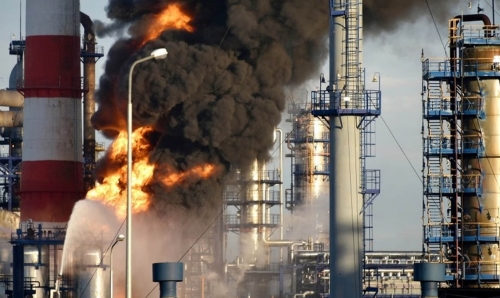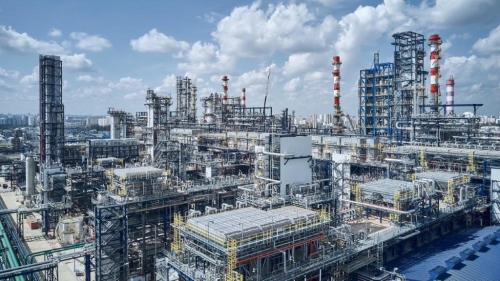Oil benchmarks climbed through most of the week on supply concerns, following new US tariffs on Venezuelan oil buyers and ratcheting up sanctions on Iran’s exports. Later in the week, oil prices retreated on renewed fears that US tariffs could impact global economic growth.
BKR Rig Count | The total active drilling rigs in the United States decreased by 1 at 592. Oil rigs decreased by 2 to 484, and gas rigs increased by 1 to 103. Rig count in the Permian Basin decreased by 3 at 297 | Mar 28 | BKR NAM Rig Count
US Crude Inventories, excluding those in the Strategic Petroleum Reserve (SPR), decreased by 3.3 MMbbl to 433.6 MMbbl (about 5% below the 5y average for this time of year). On the products side, gasoline decreased by 1.4 MMbbl (2% above the 5y average). Distillate fuels decreased by 0.4 MMbbl (7% below the 5y average). Total commercial petroleum inventories increased by 3.2 MMbbl | Mar 21 | EIA Weekly Report
Oil producing countries will probably fail to deliver the deeper output cuts they’ve pledged to compensate for earlier over-production. The countries include persistent over-producers Iraq and Kazakhstan, alongside Russia and the United Arab Emirates and even, more surprisingly, Saudi Arabia. The deeper cuts they have collectively promised start at 199,000 barrels a day for March and rise to a peak of 435,000 barrels a day by September, before tailing off again | Mar 21 | Bloomberg
US Secretary of State Marco Rubio warned Venezuela that any attempt to invade Guyana or threaten Exxon Mobil’s operations in the country would be a “very bad move.” Maduro’s military and naval arsenal dwarfs Guyana’s, which was one of the continent’s poorest countries prior to Exxon’s 2015 discovery of oil | Mar 27 | Bloomberg
President Donald Trump issued an order allowing a 25% tariff to be imposed on any nation purchasing oil and gas from Venezuela, ratcheting up his dispute with the Latin American country over immigration, aiming to cut a major source of revenue for the regime of Nicolás Maduro in Caracas while also putting further pressure on China, which is a major purchaser of Venezuelan crude and already in the cross hairs for 20% tariffs under Trump | Mar 24 | Bloomberg
Venezuela is boosting oil exports to China to the highest in almost two years as the Trump administration deploys sanctions and secondary tariffs to squeeze the Latin American nation. Shipments are set to rise to 400,000 barrels a day this month, the highest since June 2023, according to preliminary data from shipping reports | Mar 27 | Bloomberg
Close to a dozen US-sanctioned tankers are idling off Malaysia with Iranian crude, with some having been stationed in the oil-transfer hub for more than a month — possible sign of slowing logistics for the sensitive trade to China. For now, it’s not entirely clear if the oil-laden tankers off Malaysia are waiting to conduct ship-to-ship transfers, or whether they’re just awaiting buying interest from private refineries in China | Mar 27 | Bloomberg
US tariffs on copper imports could be coming within several weeks, months earlier than the deadline for a decision, according to people familiar with the matter. Goldman Sachs had expected a 25% copper tariff to be implemented between September and November, analysts said Wednesday in an emailed note | Mar 26 | Bloomberg
European natural gas extended declines as ample supplies of LNG and warmer weather eased pressure on inventories after a rocky start to the year. Benchmark futures fell as much as 2.7%, with monthly imports of liquefied natural gas into northwest Europe set to jump more than 25% from a year earlier | Mar 26 | Bloomberg
China is rapidly cutting back on its seaborne gas imports, threatening growth forecasts that have driven multibillion-dollar spending on projects across the globe. Chinese purchases of liquefied natural gas will fall this year for the first time since 2022. A sustained drop in consumption risks a glut later this decade, when more projects come online | Mar 25 | Bloomberg
Looking ahead
S&P Global Crude Oil Market Short-Term Outlook | President Donald Trump wants lower oil prices. OPEC+ is slowly raising production. Global trade is troubled by higher US tariffs on imports — and Trump’s willingness to use trade policy to shape oil trade. Crude oil inventories remain low, which supports prices, but spare capacity in the Middle East remains high at about 6 million b/d — more than double the typical level. Iran remains a wild card. The net impact is Dated Brent prices are expected to be flat to lower in second quarter 2025 as economic growth slows and oil inventories rise. A temporary price bump could come in the third quarter as inventories seasonally decline. OPEC+ in early March decided to increase production in April. The need to maintain OPEC+ unity plus the nascent rapprochement between the US and Russia, which involved Saudi Arabia, drove the decision, as per S&P view. S&P expects the actual increase to be limited this year, but it reaffirms that there is little appetite for further production cuts. New and threatened tariffs on US imports — along with reactions by trade partners — are a downside risk to world economic and oil demand growth. S&P base outlook projects world liquids demand growth of 1.2 million b/d and crude oil demand growth of 375,000 b/d in 2025. However, full implementation of threatened tariffs could reduce liquids demand growth by as much as 500,000 b/d and crude oil demand growth by up to 250,000 b/d. 2026 estimates of liquid demand growth of 800,000 b/d and crude demand growth of 700,000 b/d are also at risk if tariffs increase and spread. In the first half of 2025, at the global level crude supply is expected to exceed demand by about 750,000 b/d, which will boost crude oil inventories that are currently at low levels. Iran is a wild card. The Trump administration continues its tough talk on Iran. S&P base case projects a drop in Iranian production, but by not nearly as much as in 2018–19 during Trump’s first term. China — the main buyer of Iranian crude oil — is not interested in respecting unilateral US sanctions. With crude supply growth exceeding crude demand growth, S&P expects prices for Dated Brent to drift in the low $70s/b in the second to the third quarters of 2025. 2025 annual averages for Dated Brent and WTI are $72/b and $67/b, respectively. The 2026 averages are $69/b for Dated Brent and $64/b for WTI | Mar 26 | S&P
Global Gas: Emerging markets drive further demand growth through mid-2030s, before reaching its peak | Natural gas consumption in 2024 was about 4.0 Tcm, providing 23% of global primary energy, a smaller share than oil (30%) or coal (26%). Although gas consumption has doubled over the past 30 years, its growth rate has slowed. Over the previous decade, the annual average growth rate dropped to 2.0% per year, influenced by greater electrification and renewable deployment in OECD markets. This slowdown is forecast to continue. In our base case view, we expect natural gas demand to grow at an average rate of 0.9% per year over the next decade, reaching about 4.5 Tcm in 2037 (staying broadly flat at about 23% share of primary energy), followed by a plateau and gradual decline to about 4.4 Tcm in 2050. However, the regions with the strongest gas demand growth do not align with the regions with the strongest production growth. Therefore, there will be a growing need for global trade to connect markets. Even as overall natural gas demand peaks in the mid-2030s, LNG consumption is expected to continue increasing, albeit at a slower pace. Overall, LNG trade is forecast to grow from 560 Bcm in 2024 (representing 14% of total global gas supply) to 880 Bcm in 2032, and then more slowly to 1000 Bcm in 2050 (23% of global supply). OECD natural gas demand likely peaked in 2021. Growth for natural gas consumption will be concentrated in non-OECD markets, where energy needs are expanding faster, and policy decisions are likely to have a greater weighting toward lower-cost fuel options. Natural gas is not expected to be cost-competitive with coal in emerging markets, so policy measures will be needed to drive gas demand growth. In the Inflections base case, about 40% of today’s coal-fired generation is substituted by other fuels by 2050, mostly driven by policy rather than the economics of the fuel costs alone. Natural gas displaces just over half of this reduced coal volume, with the rest largely covered by increased renewables and nuclear capacity. ‒ In the base case outlook, about two-thirds of the oil-fired generation is replaced by 2050. Whereas growth opportunities for LNG in the transportation sector are expected to be capped by the growing use of alternative fuels such as ammonia, methanol, hydrogen and batteries | Mar 26 | S&P

%20(1).png)



